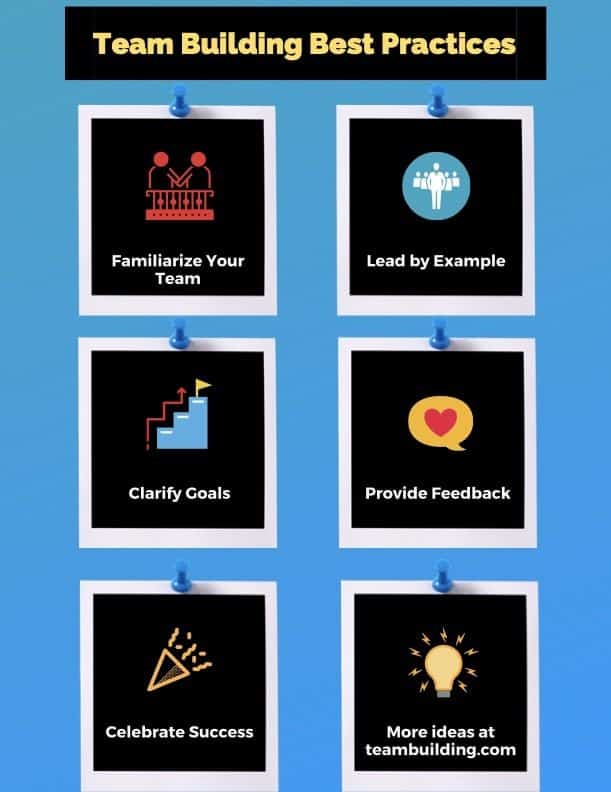Here is our list of team building best practices.
Team building best practices are standards and fundamentals which create productive groups that perform consistently. Leaders that follow team building best practices align teams with organization goals and achieve timely results.
These principles are similar to tips for team building, team building techniques, and employee engagement best practices.
This list includes:
- team building best practices for work
- the fundamentals of team building
- golden rules for team building
Alright, here is the list!
List of team building best practices
Team building best practices act as a blueprint for designing practical and proactive teams that function harmoniously. Read on for our list of guidelines for effective team building.
1. Familiarize Your Team
When you onboard a new team member you should ensure to outline the roles and responsibilities of each team member. For example, announcing, “this is Regina from HR,” is less helpful than noting, “Regina from HR can answer any questions you may have about payroll.” Similarly, summarizing a new hire’s duties to the rest of the team helps the team set clear expectations for the new member and prevents unnecessary friction.
You should also seize opportunities to acquaint team members on a personal level. Employees should see teammates as human beings, not positions. Promoting friendly relationships between team members results in decreased conflict and increased group motivation. You can help teams develop rapport by providing communal areas like break rooms and team chats, planning social events like happy hours or group volunteer days, and incorporating team building activities such as icebreakers and challenges into meetings.
Here is a list of icebreaker games to help connect new teammates, and a list of virtual onboarding ideas.
2. Lead by Example
Leading by example is one of the golden rules for team building. Being a model leader means modeling ideal team building behavior to your team. If you preach the virtues of teamwork but disrespect coworkers and harm team productivity, then your teammates will tune out your sermons. No one will listen to your advice if you do not follow your own rules.
How to model teamwork:
- Refrain from gossip
- Consider teammates’ input
- Praise other teammates’ contributions
- Communicate delays or plan changes
- Complete your part of the work on time
- Offer help
- Delegate tasks
- Ask for help when necessary
- Regulate emotions
- Accept criticism graciously
The above list contains a few examples of positive teammate behavior, but there are many other ways to exhibit effective teamwork. If you act with integrity then your team will respect you. Attitudes are contagious, and colleagues will mirror your actions. By being the change you want to see in your team, you can accelerate the growth of a considerate, collaborative, and competent group.
Here are more important leadership skills.
Want some free team building tools?
$49 value (100% free)
- 100+ fully tested icebreaker questions
- 24+ themed Bingo generators
- 5+ PDFs (including the 8% Rule)
- 2024 team building calendar
- and more...

Enter your email for instant access
3. Clarify Goals
One of my favorite quotes is, “If one does not know to which port one is sailing, no wind is favorable.” The philosopher Seneca first shared these wise words. The phrase means that good luck and proper tools can help you but cannot guide you. In other words, you need to know where you want to go, or else you will never get anywhere.
Your company can hire talented employees and supply teams with unlimited resources, but without clear direction your teams will not progress. Individual workers can set personal targets, but will fail to meet organizational benchmarks. Companies flourish when employees combine abilities and work towards common goals. Teammates need a unified vision, and leaders need to shape that vision.
You can establish a clear goal by defining what success looks like for your team and plotting ways to reach that end. Be sure that every teammate understands respective roles and responsibilities. Knowing what part each member plays in the success structure helps teams collaborate. Furthermore, assigning roles at the start of an undertaking prevents later disagreements. By holding each teammate accountable for portions of the work you establish accountability. Dividing work in this way ensures employees can focus on the correct tasks.
Clarifying goals and roles within a team provides teams with concrete objectives and stabilizes the workflow. With a clear mark in mind, team productivity is likely to increase.
4. Provide Feedback
Providing feedback is one of the top team building best practices for work. Constructive criticism means reflecting on performance and suggesting change. Feedback is a critical component of the team building process. You can give your team all the instructions in the world, but if you do not review and evaluate your employees’ performance, then your teams will not improve.
Most of us are terrible self-critics. We are either too harsh or too lenient, and we often have blindspots. We can make errors that are obvious to others and downplay our own successes. Teammates can present a more objective view of our strengths and weaknesses. Colleagues offer different perspectives and possess varying experience levels and skills, making our coworkers a valuable resource. While we struggle to identify potential improvements on our own, coworkers can help us grow by making valuable suggestions.
Teams need feedback because every team member contributes to or detracts from the group’s success. If a teammate underperforms, then the whole team suffers. If a teammate becomes more efficient, then the whole team benefits. Providing timely feedback can ward off disharmony and boost group productivity.
Dispensing feedback regularly normalizes constructive criticism. Employees will expect recommendations instead of feeling singled out for underperformance. Routine assessment places employees in a growth mindset and encourages teammates to strive for excellence.
Learn more about how to give employee feedback.
5. Celebrate Success
Celebrating shared wins is one of the fundamentals of team building. Of all the teams I have ever worked with, the ones I remember most fondly are the teams that celebrated success.
Two important team building phrases are “thank you,” and “we did it.” While it is important to coach teammates on areas of improvement, it is just as vital to call attention to achievements.
Great teams form a culture of congratulations by acknowledging exemplary performance. For instance, here at teambuilding.com, we have a Slack channel called #you-are-awesome where teammates give each other shout outs for a job well done.
Other ways to celebrate success:
- Start or end meetings with performance highlights
- Recognize a “teammate of the month”
- Present employees awards
- Plan events or special treats
- Share “kudos,” short thank-you’s for kind acts or impressive feats
- Get in the habit of saying “thank you,” and “nice work,”
Whatever the expression of thanks, you can involve the entire team in the act of appreciation. An employee will feel more connected to coworkers if the group recognizes the effort, which encourages a “we are all in this together,” mentality. Observing accomplishment motivates employees towards exceptional performance. When teams support individual members, the act invokes fellowship and fosters feelings of belonging, leading to greater employee satisfaction and less turnover.

Final Thoughts
Team building best practices are a set of guidelines that help managers foster healthier team dynamics in the workplace. These rules and basic principles form the foundation of collaboration and provide a roadmap for transforming loosely associated groups of coworkers into super teams.
Next, check out this collection of books for new managers and this list of tips to improve cooperation at work.
